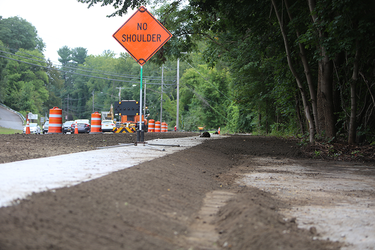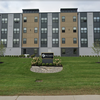Guilderland Town Board approves new bike path and sidewalks, repaving roads
GUILDERLAND — This growing suburban town is continuing in its quest to give cyclists and walkers a place to navigate amidst the traffic.
The Guilderland Town Board, at its April 18 meeting, approved plans for a bike-pedestrian path to be built along the south side of Route 146 and for more sidewalks on Carman Road and along East Old State Road.
The asphalt path will be part of the state Department of Transportation project replacing the bridge over Route 146, said supervisor Peter Barber. The pathway “would provide a linkage from Tawasentha Park over the bridge up to the winter rec area,” he said.
All four town board members present — Barber, Amanda Beedle, Rosemary Centi, and Jake Crawford — voted in favor of using $250,000 from the town’s general fund to get the Route 146 pathway project underway.
Money from the State Multi-Modal Program, acquired through Assemblywoman Patricia Fahy, will ultimately pay for the project, said Barber, crediting the town’s grant writer, Donald Csaposs, for making the connection.
“We are now also looking to see if we might be able to add some additional funding that will extend that up to [Route] 20,” said Barber.
The long-term goal, which is part of the town’s comprehensive plan and neighborhood studies, Barber said, is to have a “bicycle connection that will lead into Guilderland Center and, who knows, potentially into the village [of Altamont] at some point.”
Barber also said, “Multi-Modal can be tough, tough to get. But when you get it, it’s very fungible. DOT likes working with Multi-Modal dollars so it’s a really nice deal.”
The town has to contribute 20 percent to the project, Barber said, which is usually fulfilled with in-kind work. “They might help you with some of the grading, some of the post construction, seeding grass and whatnot,” he said. “Very rarely do we have to put dollars into that effort.”
“I think it’s a great project,” said Crawford. “I think it’s a great use of grant funding and partnership with Assemblymember Fahy to link the two areas.”
The two sidewalk projects also involve grant funding. The new Carman Road sidewalk is to run from Okara Drive to Old State Road while the sidewalk along East Old State Road will run from Carman Road to Hillview Drive.
Current approved costs are $628,000 for the new Carman Road sidewalk and $1,138,000 for the East Old State Road sidewalk, according to an April 4 memo from Csaposs to the board. State funds will cover 80 percent of the costs, he wrote.
He also wrote that work on the two projects is being combined because the sidewalks will adjoin one another and also because “it is anticipated that combining them will result in operational efficiency as well as some potential level of cost savings.”
Barber told the board, “It’s part of our long-term plan to have a continuous sidewalk on Carman Road, hopefully on both sides in certain areas, but also start going down town roads.”
He added that the sidewalk built last year to Lynnwood Elementary School has been “very popular” and went on, “We’ll get to not only … the school but also shopping and whatnot.”
All four board members voted in favor of contracting with CHA Consulting Inc. for the design, engineering, survey, right-of-way, and construction inspection for the two sidewalks. CHA helped the town get grant money, Barber said.
Crawford said it will “be great to link those neighborhoods together too and hopefully, as people are driving up and down, … [they’ll] see how much more of a neighborhood it is and slow down a little bit.”
Barber said a speed-limit sign will be placed along that stretch.
“It’s great for the Fort Hunter community,” said Beedle, “because it allows them to get down to where Corner Ice Cream is.”
Centi asked about installing a sign to identify the Fort Hunter hamlet.
Barber responded that had been discussed but may cause confusion since it’s an entry point for the town of Guilderland. Crawford suggested that a Fort Hunter sign could be placed at the corner of Old State and Carman roads.
Paving projects
The board also followed what Barber termed “a very antiquated” New York State Highway Law in agreeing to the roads Highway Superintendent Gregory Wier plans to pave this year.
“Weather & equipment breakdowns will always be a factor if we can complete all roads on the list,” Weir wrote in an April 12 memo to the board.
The recommendation, Weir said, is that each mile of town roads have some form of surface treatment every 10 years, which means paving 16.8 miles per year.
“My request is much less than that covering only 9.56,” he wrote.
The reason for paving less than the usual 10-percent of the town’s 168 miles of roads, Barber said, is “paving costs are continuing to go up. Last year, they were $50.25 per ton for asphalt … it’s now $62 — it’s going in the wrong direction.”
He added, “I think Greg always wants to have about $100,000 left over just in case something goes wrong.”
Weir wrote that he plans to pay for the paving with $450,000 in funding from Pave NY and CHIPs (Consolidated Local Street and Highway Improvement Program); $205,000 collected through the highway tax levy, and $204,000 from escrow accounts.
“This does not take into effect the cost to grind and patch roads that we are not paving this year,” Weir wrote. “That cost can reach to another $100,000.”
Streets in McKownville where water and stormwater improvements were made — Elmwood, Glenwood, Norwood, and Parkwood — are slated for paving once the infrastructure work is complete.
Also listed for paving are Frenchs Mill, Fuller Station, and Ostrander roads in one group; Alexander, Danielle, Dibella, Jaclyn, Penny, Sheldon, and Timothy in another group; and Country, Dillenbeck, Highland, Lone Pine, Oak, Shady, and Valley in a final group.
Settlement with NEIP
The board approved a settlement of the tax certiorari proceeding for the year 2019 brought by Northeastern IP Holdings Inc. A decision by Judge Margaret Walsh of Albany County Supreme Court had reduced the industrial park’s assessment from about $73 million to about $43 million.
The town of Guilderland and the two school districts affected by the decision — Guilderland and Voorheesville — “were not happy,” wrote Guilderland’s assessor, Heather Weinhold, in an April 10 memo to the town board.
“We felt there were a few items that were overlooked such as a value for excess land on the properties,” Weinhold wrote.
Ultimately, a settlement was reached, valuing the property at $45,000,000 with a 50-percent reduction of the calculated interest; the settlement will apply for the next three assessment rolls through 2025 unless specific changes are made to the property.
Barber said both school districts were “very pleased” with the settlement.
The Guilderland Central School District, after Walsh’s decision, was ordered to refund about $1.4 million in taxes to the industrial park. The settlement saved the school district $126,250, it was reported at the school board’s April 4 meeting.


